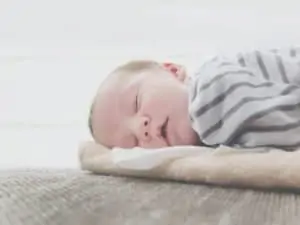Once your baby no longer likes swaddling, you start to wonder how to keep your baby warm at night. Safe sleeping practices mean that blankets are a huge no-no, so what can parents do?
Parents want their babies to sleep the best and be comfortable while sleeping, and finding the perfect temperature is part of that. No one sleeps well when they’re too cold or too warm, and babies are the same way.
Swaddling is the easiest way to keep your baby warm, but once they are too old or no longer like to be swaddled, it feels like your options to keep your baby comfortable and warm decrease.
Don’t panic!
Using wearable blankets and keeping your baby’s nursery at the right temperature range is part of what parents can do. Here is what you need to do to keep your baby warm at night.
When Should Babies Stop Being Swaddled for Night Sleep?
Parents must stop swaddling their babies for night sleep when they start to roll from back to belly. All babies reach this milestone at a different age, but it ranges from eight weeks old to four months old.
It’s up to parents to watch their child and remove the swaddle BEFORE they start to roll over. If your baby manages to roll over before you remove the swaddle, it dramatically increases the risk of suffocation. So, if your baby exhibits signs that they might start to roll over soon, it’s time to make the transition out of a swaddle.
How to Keep Baby Warm at Night Without a Swaddle
Once you no longer swaddle your baby, parents must learn how to keep their baby warm without a swaddle. Here are some safe suggestions to try.
Avoid Blankets
Make sure that you avoid using blankets in the crib with your baby. Even though it’s tempting and well-meaning, family members might tell you that it’s safe, evidence-based safe sleeping practices show us that blankets dramatically increase the risk of SIDS.
The American Academy of Pediatrics outlines the most important safe sleeping practices as:
- Sleeping on their back for every sleep
- A firm sleep surface
- No soft objects
- No blankets, pillows, or loose bedding
- Avoid bumper pads or crib liners
Keep The Nursery at The Right Temperature
Part of keeping your baby warm at night is maintaining the proper temperature in your child’s nursery. This is similar to how you feel comfortable at night if you keep your house temperature at the right level.
You must keep a baby’s nursery between 68-72℉. Avoid keeping your baby’s room too warm because overheating increases the risk of SIDS. Since babies cannot regulate their temperature well, you also need to avoid keeping the temperature too low.

Some experts recommend keeping the temperature in your baby’s room even lower. For example, Sleep Advisor indicates that babies and toddlers sleep best when the room temperature is between 65-70℉.
The best way to monitor a nursery’s room temperature is with a baby monitor or thermometer. Advanced baby monitors display the room temperature, but a simple digital thermometer does the job as well.
Use Wearable Blankets
Blankets are a huge no-no when your baby is asleep, but a safe option after your baby phases out of the swaddle is to use wearable blankets. These blankets cover your baby’s legs loosely, and some have sleeves, but they leave their arms available to roll and push up to avoid suffocation.
Babies and parents love wearable blankets, and they have a long lifespan. Wearable blankets have sizes available up to 3T, so your child can use them for years to come.
In the winter, consider using a thicker wearable blanket made of microfleece and use a cotton one in the summer to avoid overheating.
Use Cozy Fitted Sheets
Have you ever added cozy, flannel sheets on your bed and noticed how much warmer you felt?
One way to make your baby feel warmer at night is by using warm, cozy, fitted sheets for your baby’s crib. Chenille or flannel are two fantastic options that will provide a layer of comfort and warmth while your baby sleeps.
Add Extra Layers Under the Wearable Blanket
If you need to keep your baby warm at night, consider adding extra layers under your baby’s wearable blanket. Adding onesies or socks underneath helps to keep your baby warm without overheating.
Be cautious about how many extra layers that you put on your baby. In the winter, a wearable blanket plus a sleeper should be sufficient at keeping your baby warm.
Keep Baby Away From Windows and Vents
Make sure you properly position your baby’s crib. Place your baby’s crib or bassinet away from windows, fans, air vents, or outside walls that might be colder.
How Do I Know If Baby Is Too Cold at Night?
The easiest way to determine if your baby is too cold at night is by touching his neck. If your baby’s neck is cold to the touch, then he’s too cold. If his neck is sweaty, your baby is too hot, and you need to remove layers to avoid overheating.
Take a look at your baby’s hands and feet. Since babies cannot regulate their temperature, their hands and feet become cold before the rest of their bodies.

Parents might worry that if their baby is too cold, they have increased risks like they do when they overheat. The risk of becoming too cold, assuming that they’re inside and not an environment where they face hypothermia, is that they might be less responsive.
If you notice that your baby becomes lethargic when he’s too cold, talk to your pediatrician.
Is It Ok If My Baby’s Hands Are Cold at Night?
Don’t use your baby’s hands and feet as a guide for how to dress your infant at night. Babies have poor circulation and an inability to regulate their temperature. Together, that means a baby’s hands and feet often feel cold to the touch, and they might even look blue.
If you want to know whether or not your baby is cold, touch his chest or neck. Those locations are a better indicator of your baby’s true, core temperature. Here are a few reasons why your baby might have cold hands at night.
Temperature Regulation
Babies have a core temperature that tends to run warmer than an adult, so when you touch their chest and compare that to their hands or feet, it might seem like a big difference.
When babies are born, they cannot regulate their temperature quickly, so it often means that less heat is delivered to their legs, feet, arms, and hands.
Low Activity Level
Babies spend a lot of their time in low activity mode – eating, sleeping, and digesting. When babies sleep, their bodies aren’t moving around or exerting energy. That’s normal for babies, but it leads to cold hands.
Note that:
When babies don’t move around, it means that they have less blood flow to their limbs. Digesting their food keeps their stomach and core body warm but not their hands.
As your baby gets older and starts to spend more time playing and moving, you’ll notice his hands and feet aren’t as cold.
Poor Circulation
If your baby is under the age of three months old, their blood circulatory system is new. It brings less blood and heat to the areas farthest away from the heart, including the hands and feet. Their bodies spend a lot of time developing their lungs and brain, so if your baby’s hands are cold, don’t panic.
How to Keep Baby’s Hands Warm at Night Without Swaddle
Part of keeping your baby warm at night involves following safe sleeping guidelines, so if you want to keep your baby’s hands warm, what can you do?
The National Sleep Foundation says that infants can wear soft mittens to sleep to avoid scratching their faces but make sure your baby’s mittens fit properly and won’t fall off. If they fall off on your baby’s face, they might be a suffocation risk. Mittens with strings or loose threads pose a choking hazard, so use plain, cloth mittens.
However, if your baby’s hands are cold at night but his core temperature is fine, you don’t have to worry. Your baby will be fine.
Final Thoughts
All babies phase out of using a swaddle at some point, and you must know how to keep your baby warm at night without a swaddle. Remember to use a wearable blanket and keep your baby’s room temperature at a safe range. Check your baby’s body temperature often by feeling their chest or neck to avoid overheating or becoming too cold.
Hey, this is Linda. My biggest accomplishment in life is being a mother of four children. Their current ages range from almost ten years old down to 20 months old.
I’m passionate about writing parenting articles because I understand so well all of the problems and trials you face as a parent. From breastfeeding woes to budgeting problems and behavior problems, along with everything in between, chances are I’ve faced it over the last ten years. Read more about Linda here.






